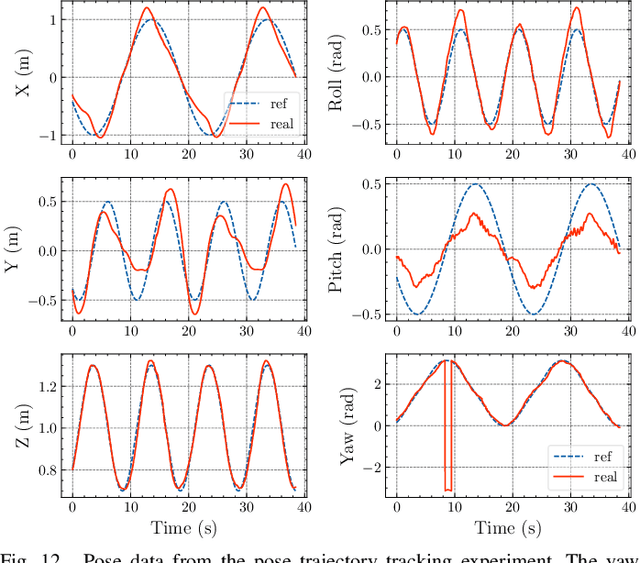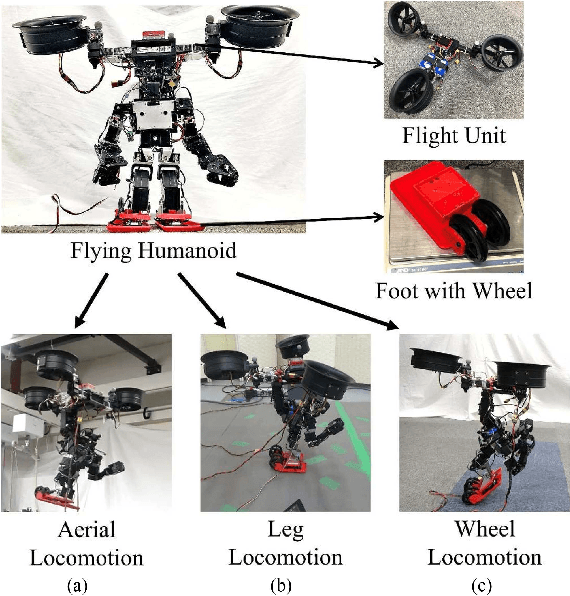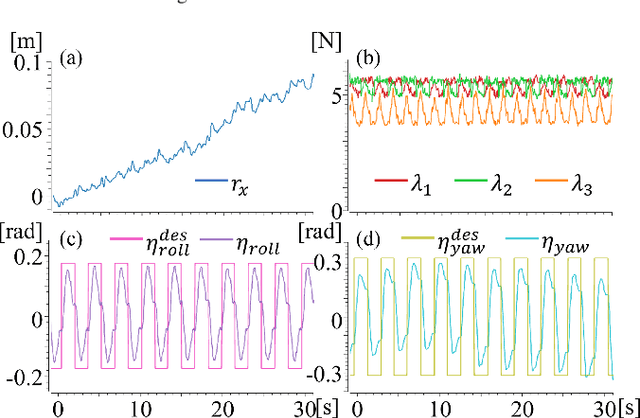Moju Zhao
Flexible Morphing Aerial Robot with Inflatable Structure for Perching-based Human-Robot Interaction
Sep 09, 2025Abstract:Birds in nature perform perching not only for rest but also for interaction with human such as the relationship with falconers. Recently, researchers achieve perching-capable aerial robots as a way to save energy, and deformable structure demonstrate significant advantages in efficiency of perching and compactness of configuration. However, ensuring flight stability remains challenging for deformable aerial robots due to the difficulty of controlling flexible arms. Furthermore, perching for human interaction requires high compliance along with safety. Thus, this study aims to develop a deformable aerial robot capable of perching on humans with high flexibility and grasping ability. To overcome the challenges of stability of both flight and perching, we propose a hybrid morphing structure that combines a unilateral flexible arm and a pneumatic inflatable actuators. This design allows the robot's arms to remain rigid during flight and soft while perching for more effective grasping. We also develop a pneumatic control system that optimizes pressure regulation while integrating shock absorption and adjustable grasping forces, enhancing interaction capabilities and energy efficiency. Besides, we focus on the structural characteristics of the unilateral flexible arm and identify sufficient conditions under which standard quadrotor modeling and control remain effective in terms of flight stability. Finally, the developed prototype demonstrates the feasibility of compliant perching maneuvers on humans, as well as the robust recovery even after arm deformation caused by thrust reductions during flight. To the best of our knowledge, this work is the first to achieve an aerial robot capable of perching on humans for interaction.
Falconry-like palm landing by a flapping-wing drone based on the human gesture interaction and distance-aware flight planning
Jul 23, 2025Abstract:Flapping-wing drones have attracted significant attention due to their biomimetic flight. They are considered more human-friendly due to their characteristics such as low noise and flexible wings, making them suitable for human-drone interactions. However, few studies have explored the practical interaction between humans and flapping-wing drones. On establishing a physical interaction system with flapping-wing drones, we can acquire inspirations from falconers who guide birds of prey to land on their arms. This interaction interprets the human body as a dynamic landing platform, which can be utilized in various scenarios such as crowded or spatially constrained environments. Thus, in this study, we propose a falconry-like interaction system in which a flapping-wing drone performs a palm landing motion on a human hand. To achieve a safe approach toward humans, we design a trajectory planning method that considers both physical and psychological factors of the human safety such as the drone's velocity and distance from the user. We use a commercial flapping platform with our implemented motion planning and conduct experiments to evaluate the palm landing performance and safety. The results demonstrate that our approach enables safe and smooth hand landing interactions. To the best of our knowledge, it is the first time to achieve a contact-based interaction between flapping-wing drones and humans.
Six-DoF Hand-Based Teleoperation for Omnidirectional Aerial Robots
Jun 17, 2025Abstract:Omnidirectional aerial robots offer full 6-DoF independent control over position and orientation, making them popular for aerial manipulation. Although advancements in robotic autonomy, operating by human remains essential in complex aerial environments. Existing teleoperation approaches for multirotors fail to fully leverage the additional DoFs provided by omnidirectional rotation. Additionally, the dexterity of human fingers should be exploited for more engaged interaction. In this work, we propose an aerial teleoperation system that brings the omnidirectionality of human hands into the unbounded aerial workspace. Our system includes two motion-tracking marker sets -- one on the shoulder and one on the hand -- along with a data glove to capture hand gestures. Using these inputs, we design four interaction modes for different tasks, including Spherical Mode and Cartesian Mode for long-range moving as well as Operation Mode and Locking Mode for precise manipulation, where the hand gestures are utilized for seamless mode switching. We evaluate our system on a valve-turning task in real world, demonstrating how each mode contributes to effective aerial manipulation. This interaction framework bridges human dexterity with aerial robotics, paving the way for enhanced teleoperated aerial manipulation in unstructured environments.
Hierarchical Language Models for Semantic Navigation and Manipulation in an Aerial-Ground Robotic System
Jun 05, 2025Abstract:Heterogeneous multi-robot systems show great potential in complex tasks requiring coordinated hybrid cooperation. However, traditional approaches relying on static models often struggle with task diversity and dynamic environments. This highlights the need for generalizable intelligence that can bridge high-level reasoning with low-level execution across heterogeneous agents. To address this, we propose a hierarchical framework integrating a prompted Large Language Model (LLM) and a GridMask-enhanced fine-tuned Vision Language Model (VLM). The LLM performs task decomposition and global semantic map construction, while the VLM extracts task-specified semantic labels and 2D spatial information from aerial images to support local planning. Within this framework, the aerial robot follows a globally optimized semantic path and continuously provides bird-view images, guiding the ground robot's local semantic navigation and manipulation, including target-absent scenarios where implicit alignment is maintained. Experiments on a real-world letter-cubes arrangement task demonstrate the framework's adaptability and robustness in dynamic environments. To the best of our knowledge, this is the first demonstration of an aerial-ground heterogeneous system integrating VLM-based perception with LLM-driven task reasoning and motion planning.
Vectorable Thrust Control for Multimodal Locomotion of Quadruped Robot SPIDAR
Mar 14, 2025Abstract:In this paper, I present vectorable thrust control for different locomotion modes by a novel quadruped robot, SPIDAR, equipped with vectoring rotor in each link. First, the robot's unique mechanical design, the dynamics model, and the basic control framework for terrestrial/aerial locomotion are briefly introduced. Second, a vectorable thrust control method derived from the basic control framework for aerial locomotion is presented. A key feature of this extended flight control is its ability to avoid interrotor aerodynamics interference under specific joint configuration. Third, another extended thrust control method and a fundamental gait strategy is proposed for special terrestrial locomotion called crawling that requires all legs to be lifted at the same time. Finally, the experimental results of the flight with a complex joint motion and the repeatable crawling motion are explained, which demonstrate the feasibility of the proposed thrust control methods for different locomotion modes.
Servo Integrated Nonlinear Model Predictive Control for Overactuated Tiltable-Quadrotors
May 16, 2024



Abstract:Quadrotors are widely employed across various domains, yet the conventional type faces limitations due to underactuation, where attitude control is closely tied to positional adjustments. In contrast, quadrotors equipped with tiltable rotors offer overactuation, empowering them to track both position and attitude trajectories. However, the nonlinear dynamics of the drone body and the sluggish response of tilting servos pose challenges for conventional cascade controllers. In this study, we propose a control methodology for tilting-rotor quadrotors based on nonlinear model predictive control (NMPC). Unlike conventional approaches, our method preserves the full dynamics without simplification and utilizes actuator commands directly as control inputs. Notably, we incorporate a first-order servo model within the NMPC framework. Through simulation, we observe that integrating the servo dynamics not only enhances control performance but also accelerates convergence. To assess the efficacy of our approach, we fabricate a tiltable-quadrotor and deploy the algorithm onboard at a frequency of 100Hz. Extensive real-world experiments demonstrate rapid, robust, and smooth pose tracking performance.
BEATLE -- Self-Reconfigurable Aerial Robot: Design, Control and Experimental Validation
Apr 14, 2024Abstract:Modular self-reconfigurable robots (MSRRs) offer enhanced task flexibility by constructing various structures suitable for each task. However, conventional terrestrial MSRRs equipped with wheels face critical challenges, including limitations in the size of constructible structures and system robustness due to elevated wrench loads applied to each module. In this work, we introduce an Aerial MSRR (A-MSRR) system named BEATLE, capable of merging and separating in-flight. BEATLE can merge without applying wrench loads to adjacent modules, thereby expanding the scalability and robustness of conventional terrestrial MSRRs. In this article, we propose a system configuration for BEATLE, including mechanical design, a control framework for multi-connected flight, and a motion planner for reconfiguration motion. The design of a docking mechanism and housing structure aims to balance the durability of the constructed structure with ease of separation. Furthermore, the proposed flight control framework achieves stable multi-connected flight based on contact wrench control. Moreover, the proposed motion planner based on a finite state machine (FSM) achieves precise and robust reconfiguration motion. We also introduce the actual implementation of the prototype and validate the robustness and scalability of the proposed system design through experiments and simulation studies.
Design and Control of Delta: Deformable Multilinked Multirotor with Rolling Locomotion Ability in Terrestrial Domain
Mar 11, 2024



Abstract:In recent years, multiple types of locomotion methods for robots have been developed and enabled to adapt to multiple domains. In particular, aerial robots are useful for exploration in several situations, taking advantage of its three-dimensional mobility. Moreover, some aerial robots have achieved manipulation tasks in the air. However, energy consumption for flight is large and thus locomotion ability on the ground is also necessary for aerial robots to do tasks for long time. Therefore, in this work, we aim to develop deformable multirotor robot capable of rolling movement with its entire body and achieve motions on the ground and in the air. In this paper, we first describe the design methodology of a deformable multilinked air-ground hybrid multirotor. We also introduce its mechanical design and rotor configuration based on control stability. Then, thrust control method for locomotion in air and ground domains is described. Finally, we show the implemented prototype of the proposed robot and evaluate through experiments in air and terrestrial domains. To the best of our knowledge, this is the first time to achieve the rolling locomotion by multilink structured mutltrotor.
Design and Control of a Humanoid Equipped with Flight Unit and Wheels for Multimodal Locomotion
Mar 26, 2023



Abstract:Humanoids are versatile robotic platforms because of their limbs with multiple degrees of freedom. Although humanoids can walk like humans, the speed is relatively slow, and they cannot run over large barriers. To address these problems, we aim to achieve rapid terrestrial locomotion ability and simultaneously expand the domain of locomotion to the air by utilizing thrust for propulsion. In this paper, we first describe an optimized construction method of a humanoid robot equipped with wheels and a flight unit to achieve these abilities. Then, we describe the integrated control framework of the proposed flying humanoid for each mode of locomotion: aerial locomotion, leg locomotion, and wheel locomotion. Finally, we achieved multimodal locomotion and aerial manipulation experiments using the robot platform proposed in this work. To the best of our knowledge, it is the first time to achieve three different types of locomotion, including flight, by a single humanoid.
Design, Control, and Motion Strategy of TRADY: Tilted-Rotor-Equipped Aerial Robot With Autonomous In-flight Assembly and Disassembly Ability
Mar 14, 2023Abstract:In previous research, various types of aerial robots were developed to improve maneuverability or manipulation abilities. However, there was a challenge in achieving both mobility and manipulation capabilities simultaneously. This is because aerial robots with high mobility lack the necessary rotors to perform manipulation tasks, while those with manipulation ability are too large to achieve high mobility. To address this issue, a new aerial robot called TRADY was introduced in this article. TRADY is a tilted-rotor-equipped aerial robot that can autonomously assemble and disassemble in-flight, allowing for a switch in control model between under-actuated and fully-actuated models. The system features a novel docking mechanism and optimized rotor configuration, as well as a control system that can transition between under-actuated and fully-actuated modes and compensate for discrete changes. Additionally, a new motion strategy for assembly/disassembly motion that includes recovery behavior from hazardous conditions was introduced. Experimental results showed that TRADY can successfully execute aerial assembly/disassembly motions with a 90% success rate and generate more than nine times the torque of a single unit in the assembly state. This is the first robot system capable of performing both assembly and disassembly while seamlessly transitioning between fully-actuated and under-actuated models.
 Add to Chrome
Add to Chrome Add to Firefox
Add to Firefox Add to Edge
Add to Edge